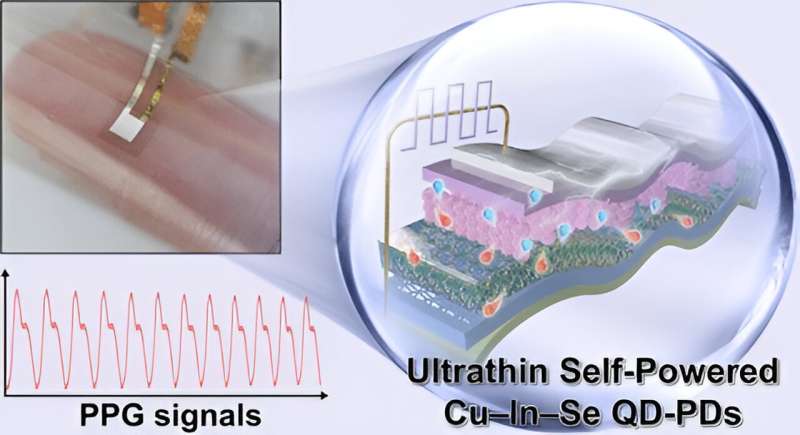This article has been reviewed according to Science X's editorial process and policies. Editors have highlighted the following attributes while ensuring the content's credibility:
fact-checked
peer-reviewed publication
proofread
High-performance quantum dot photosensor needs no external power source

Professor Ji-woong Yang at the Department of Energy Science and Engineering, Daegu Gyeongbuk Institute of Science and Technology has successfully developed the world's highest-performance eco-friendly quantum dot photosensor that does not require any external power source.
It was confirmed that the eco-friendly quantum dot photonic sensor developed through joint research with Professor Moon-kee Choi's research team at the Department of New Materials Engineering, Ulsan National Institute of Science and Technology (UNIST) and Professor Dae-hyeong Kim's research team at the Department of Chemical and Biomolecular Engineering, Seoul National University (President Hong-lim Ryu) can stably measure light signals without any external power source, due to the photovoltaic effect.
The joint research team has also produced a skin-attachable ultra-thin pulse sensor based on this photosensor, and introduced the wearable pulse sensor that can stably acquire pulse signals despite different deformations. The work is published in the journal ACS Nano.
In recent years, the aging population and the COVID-19 pandemic have led to a growing demand for health care monitoring devices that can be attached to the body for a long period of time to acquire biometric signals. Traditional silicon-based photosensors, however, are not commonly used in actual practice because they are heavy and rigid, which makes them uncomfortable to wear for a long period of time. They also cannot acquire biometric signals accurately because they cannot be in close contact with the skin.
This year's Nobel Prize in Chemistry was awarded to three scientists who discovered and developed quantum dots, which are also known as the seeds of nanoscience. Quantum dots are ultra-fine semiconductor particles, which are only a few nanometers (nm, one billionth of a meter) in size, and their better optical and electrical properties than traditional semiconductor materials allow them to quickly separate electrons and electron holes.
Since quantum dots have the advantage of fast response time when used as a photosensor, photosensor research based on quantum dots has been conducted widely. Most of the existing quantum dot photosensors, however, are thicker than a few micrometers, and most of the research uses quantum dots, such as lead sulfide (PbS), which contains toxic heavy metals. Hence, the dots cannot be used for a wearable photosensor in practice.
The research team has now successfully developed an ultra-high-performance quantum dot photosensor based on the eco-friendly quantum dots of copper-indium-selenide (Cu-In-Se), which does not contain heavy metals. It had been generally accepted that photosensors based on eco-friendly quantum dots have poor performance. Nonetheless, the research team improved the electrical properties of eco-friendly quantum dots by controlling the size and composition of the dots, developed a new organic-inorganic hybrid charge transfer layer, which is suitable for the dots, and created an eco-friendly quantum dot photosensor that surpasses the performance of existing toxic quantum dot photosensors.
The eco-friendly quantum dot photosensor created by the research team shows high device performance even with a quantum dot absorption layer of about 40 nanometers (nm). Furthermore, it shows great light-detection performance with no external power source. These two properties may serve as a great advantage for wearable photosensor applications and usage.
The research team also developed a wearable pulse sensor by combining the photosensor produced on a polymer-based flexible substrate with a light source. The sensor had the flexibility to be stably operated even in a radius of curvature of 0.5 millimeters (mm), and could stably measure the pulse even in various situations where there is movement, such as walking and running, after being attached to the human body.
Professor Ji-woong Yang said, "By controlling the structure of eco-friendly quantum dots and developing a charge transfer layer optimized for the dots, we were able to make a high-performance eco-friendly quantum dot photosensor."
UNIST Professor Moon-kee Choi stated, "We were able to create an ultra-thin pulse sensor with high flexibility based on the eco-friendly quantum dot photosensor that requires no external power source. It could be used for various next-generation photosensor applications, such as lidar and infrared cameras, as well as wearable health care monitoring systems."
More information: Shi Li et al, Ultrathin Self-Powered Heavy-Metal-Free Cu–In–Se Quantum Dot Photodetectors for Wearable Health Monitoring, ACS Nano (2023). DOI: 10.1021/acsnano.3c05178
Journal information: ACS Nano
Provided by Daegu Gyeongbuk Institute of Science and Technology (DGIST)




















